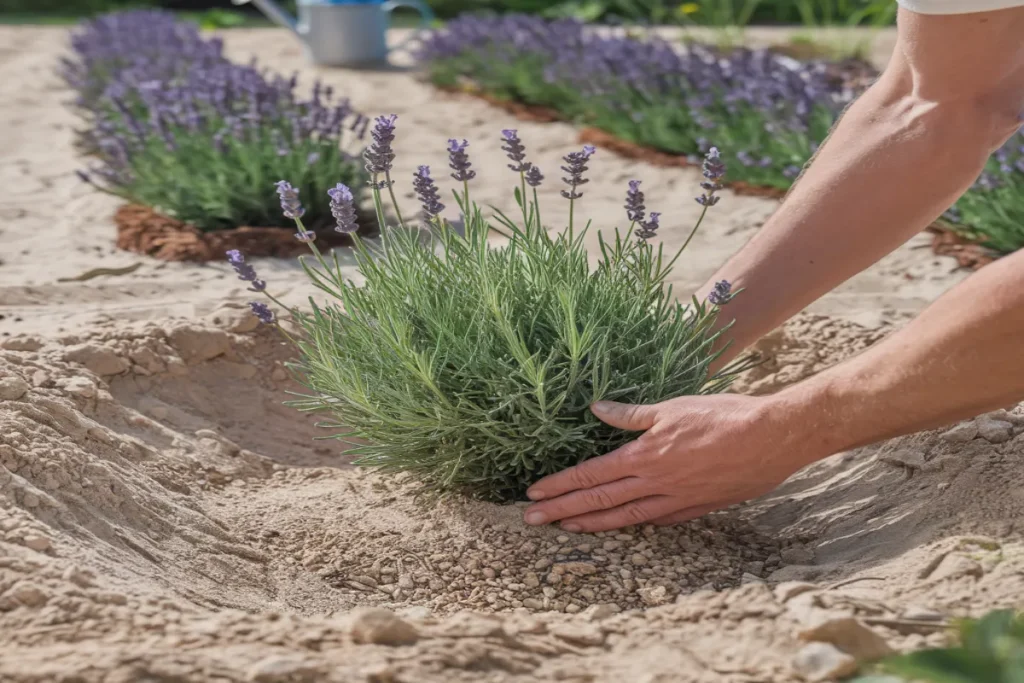In the rolling lavender fields of Provence, France, a seasoned gardener once shared a secret: understanding lavender roots is the key to cultivating these aromatic plants. How deep does lavender roots grow ? The depth of lavender roots plays a crucial role in their survival and productivity, revealing nature’s intricate design for this beloved herb.
Gardeners often wonder about the root system of lavender plants. The lavender roots typically grow to an impressive depth of 18 to 24 inches, with an average spread of 8-10 inches. This robust root structure allows the plant to access water and nutrients efficiently, making it remarkably resilient in various growing conditions.
Exploring how deep lavender roots grow provides insights into the plant’s remarkable adaptability. The root depth can vary depending on several factors, including soil type, climate, and specific lavender species. Gardeners in USDA Plant Hardiness Zones 5-9 will find lavender particularly well-suited to their landscapes.
Whether you’re a novice gardener or an experienced botanist, understanding lavender root depth is essential for successful cultivation. From the Mediterranean varieties to the English lavender, each type brings its unique root characteristics that contribute to the plant’s overall health and vitality.
Table of Contents
Understanding Lavender as a Plant
Lavender is a fascinating perennial herb that captures the hearts of gardeners across North Carolina. Native to the Mediterranean region, this aromatic plant brings beauty and fragrance to gardens while offering remarkable versatility for growing lavender in NC.
Overview of Lavender Species
The lavender genus encompasses approximately 47 known species of flowering plants in the mint family. When growing lavender in North Carolina, gardeners have several exciting options to choose from:
- English Lavender (Lavandula angustifolia): Cold-resistant, thrives in USDA zones 5-10
- Spanish Lavender (Lavandula stoechas): Blooms from mid-spring to late summer
- Hybrid Lavender (Lavandula x intermedia): Suitable for USDA zones 5-11
- Woolly Lavender: Exceptional drought-tolerant variety
Popular Varieties of Lavender
Different lavender varieties offer unique characteristics for gardeners in North Carolina. Let’s explore some popular choices:
| Variety | Height | Bloom Period | Hardiness Zones |
|---|---|---|---|
| English Lavender | 2-3 feet | Summer | 5-10 |
| French Lavender | 2-3 feet | Early Summer to Fall | 8-9 |
| Spanish Lavender | 1-2 feet | Mid-spring to Late Summer | 8-9 |
Ideal Growing Conditions for Lavender
When to plant lavender in North Carolina depends on understanding its specific growing requirements. Lavender thrives in conditions that mimic its Mediterranean origins:
- Full Sun: Minimum 6-8 hours of direct sunlight daily
- Soil: Well-draining, alkaline soil with pH 7.0 or higher
- Temperature: Hardy in USDA zones 5-9
- Planting Time: Early to late spring after the last frost
*Pro Tip*: For successful growing lavender in NC, focus on providing excellent drainage and avoiding overly rich, nitrogen-heavy soils.
By selecting the right variety and creating optimal growing conditions, North Carolina gardeners can enjoy beautiful, fragrant lavender plants that transform their landscapes.

The Anatomy of Lavender Roots
Lavender’s root system is a fascinating botanical marvel that plays a crucial role in the plant’s survival and growth. Understanding the intricate structure of lavender roots helps gardeners optimize their cultivation techniques and ensure healthy plant development.
Structure of Lavender Root System
The lavender root system is uniquely designed to support the plant’s remarkable adaptability. It consists of a primary woody taproot complemented by an extensive network of fibrous roots. This root structure allows lavender to thrive in challenging environmental conditions.
- Primary root type: Woody taproot
- Secondary root network: Fibrous roots
- Root depth: Typically 8-10 inches
- Maximum potential root depth: 18-24 inches
Root Depth Variations Across Lavender Species
How deep do lavender roots grow depends significantly on the specific species. Different varieties of lavender exhibit unique root characteristics that impact their overall growth and resilience.
| Lavender Species | Average Root Depth | Growth Characteristics |
|---|---|---|
| Lavandula angustifolia | 12-15 inches | Compact root system |
| Lavandula x intermedia | 15-18 inches | Extensive root network |
| Lavandula stoechas | 10-12 inches | Moderate root spread |
The lavender root system’s ability to adapt to various soil conditions makes it an exceptional plant for gardeners seeking drought-resistant and low-maintenance vegetation. Understanding how deep lavender roots go can help optimize planting techniques and ensure successful cultivation.
*”The secret to thriving lavender lies in understanding its remarkable root architecture.”*
Factors Influencing Root Depth
Understanding how deep are lavender roots requires exploring the critical environmental factors that impact their growth. Lavender roots develop uniquely based on specific conditions, making their root system fascinating for gardeners and plant enthusiasts.
Soil Type and Texture Impact
The soil composition significantly determines how deep lavender roots grow. Sandy, well-draining soils provide optimal conditions for root expansion. Lavender prefers alkaline soils with a pH range of 6.5 to 8.2, which enables robust root development.
- Sandy soils allow deeper root penetration
- Clay soils can restrict root growth
- Well-draining soil prevents root rot
Climate and Weather Conditions
Climate plays a crucial role in determining does lavender have deep roots. Dry and warm environments promote stronger root systems. Lavender roots typically reach 12 to 18 inches deep, with most active growth occurring during spring and fall.
Watering Practices
Proper irrigation directly influences root depth and plant health. Optimal watering techniques include:
- Allow soil to dry between watering sessions
- Avoid overwatering to prevent root rot
- Promote deeper root growth through strategic watering
“Healthy roots are the foundation of thriving lavender plants”
By understanding these factors, gardeners can cultivate lavender with strong, deep root systems that ensure plant resilience and vitality.
Typical Root Depth of Lavender
Understanding the root system of lavender is crucial for successful cultivation. Lavender roots play a vital role in the plant’s overall health and survival, with their depth and spread determining the plant’s ability to access nutrients and water.
Average Root Depth Range
The lavender root depth typically ranges from 8 to 10 inches, creating a relatively compact underground structure. Gardeners interested in how deep do lavender roots grow will find that most varieties develop a modest but efficient root system.
- Typical root depth: 8-10 inches
- Maximum potential root depth: 18-24 inches
- Root spread: Approximately 8-10 inches wide
Deep Root Growth in Established Plants
As lavender plants mature, their root system becomes more extensive. Established lavender plants can develop deeper roots, reaching up to 24 inches in optimal growing conditions. This deeper lavender root depth contributes to the plant’s remarkable drought resistance.
| Plant Stage | Root Depth | Root Characteristics |
|---|---|---|
| Young Plants | 8-10 inches | Shallow, developing root system |
| Established Plants | 18-24 inches | Deep, extensive root network |
The depth and strength of lavender roots determine the plant’s ability to survive challenging environmental conditions.
Factors such as soil type, climate, and care practices significantly influence the lavender root depth. Well-draining soil and proper planting techniques encourage robust root development, ensuring the plant’s long-term health and vitality.
Benefits of Deep Roots in Lavender
Lavender roots play a crucial role in the plant’s overall health and survival. Understanding how deep lavender roots go reveals remarkable advantages for gardeners seeking robust and resilient plants.
Deep lavender roots provide significant benefits that extend beyond simple plant stability. These underground networks offer multiple advantages for plant growth and survival.
Enhanced Nutrient Absorption
When lavender roots penetrate deeper into the soil, they unlock access to a broader range of minerals and nutrients. Deeper root systems allow plants to explore more extensive soil layers, ensuring optimal nutrition for robust growth.
- Access nutrients from multiple soil depths
- Increase overall plant resilience
- Support more extensive root networks
Improved Drought Resistance
Lavender roots that grow deeper demonstrate exceptional drought tolerance. These extensive root systems can reach moisture reserves far beneath the surface, enabling plants to survive in challenging environmental conditions.
“A well-established lavender plant with deep roots can withstand extended periods of dry weather with minimal stress.”
Stability Against High Winds
Deep roots provide critical structural support for lavender plants. The extensive root network anchors the plant firmly, preventing displacement during strong winds and maintaining the plant’s overall health.
Gardeners can encourage deep lavender roots by providing well-draining soil, appropriate spacing, and strategic watering practices. Understanding how deep lavender roots go helps create optimal growing conditions for these remarkable plants.
How to Promote Healthy Root Growth
Growing lavender in North Carolina requires careful attention to root development. Successful lavender cultivation depends on understanding the essential techniques that support robust root systems and plant health.
Proper planting techniques are crucial for establishing strong lavender roots. When considering how deep to plant lavender, gardeners should focus on creating optimal growing conditions that encourage deep and healthy root development.
Best Planting Techniques
- Select a sunny location with excellent drainage
- Dig holes 12-18 inches deep to accommodate root growth
- Space plants 18-24 inches apart for proper air circulation
- Plant during late spring after the last frost
Recommended Soil Amendments
Growing lavender in NC requires strategic soil preparation. Gardeners should focus on creating well-draining soil conditions that support root health.
| Soil Amendment | Purpose | Recommended Amount |
|---|---|---|
| Gravel | Improve drainage | 20-30% of soil mix |
| Sand | Enhance soil structure | 15-25% of soil mix |
| Organic compost | Provide minimal nutrients | 5-10% of soil mix |
Effective Watering Strategies
Mature lavender plants prefer deep, infrequent watering that encourages roots to grow deeper into the soil. For newly planted lavender, maintain consistent moisture during the first summer to support root establishment.
“Lavender roots thrive when challenged to seek water deep within the soil, creating a more resilient and drought-tolerant plant.”
By implementing these strategic planting and care techniques, gardeners can successfully cultivate lavender with strong, healthy root systems that support vigorous growth and beautiful blooms.

Frequently Asked Questions
How deep are the roots on lavender?
Lavender has a shallow root system, typically reaching about 12-18 inches deep. This is why it needs well-draining soil—too much moisture can easily lead to root rot.
How many years do lavender plants last?
Most lavender plants live 10-15 years with proper care. Some well-maintained plants can survive 20+ years, especially hardy varieties like English lavender (Lavandula angustifolia).
Does lavender need a lot of root space?
Yes, lavender needs good root space but not necessarily deep soil. It thrives in raised beds, pots, or well-draining garden soil. For best results:
✔ Use a pot at least 12 inches deep if growing in a container.
✔ Give each plant 2-3 feet of space in the garden.
Can you plant lavender near your house?
Absolutely! Lavender is a great choice for planting near foundations, walkways, or patios. It:
✅ Repels mosquitoes and pests
✅ Smells amazing near windows and doors
✅ Attracts bees and butterflies
Just make sure the spot gets full sun and has well-drained soil to avoid moisture buildup near the foundation.
Is lavender hard to dig up?
Yes, mature lavender can be tough to dig up because of its woody base and spreading roots. If you need to move it:
✔ Water it lightly a day before digging to loosen the soil.
✔ Use a sharp spade and dig wide around the root ball.
✔ Replant immediately in well-draining soil if transplanting.
Why is lavender so hard to grow?
Lavender is picky about conditions, which makes it tricky for beginners. It struggles if:
❌ The soil holds too much moisture (causes root rot).
❌ It gets too much shade (needs at least 6 hours of sun).
❌ The climate is too humid (needs airflow to prevent mold).
❌ It’s overwatered (thrives on neglect once established).
Tip: If you’ve struggled with lavender, try growing French or Spanish lavender in humid areas or English lavender in cold climates!

